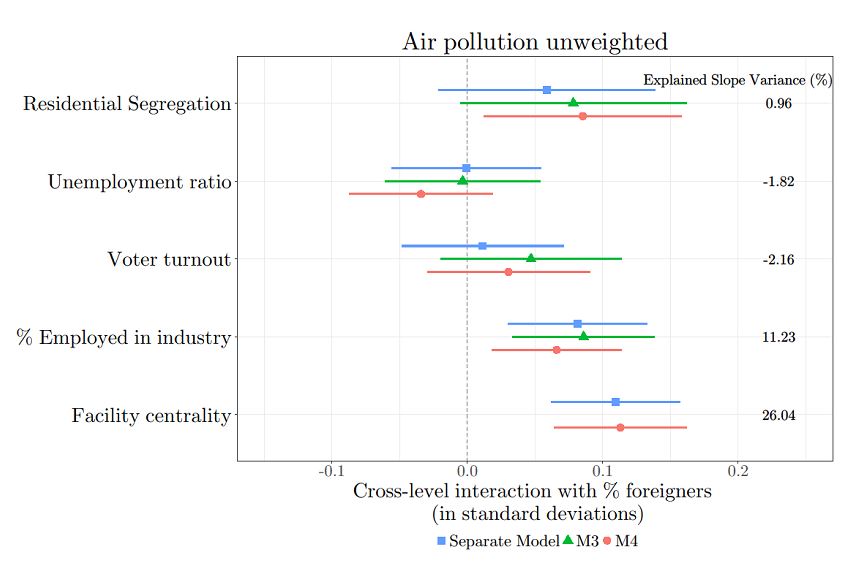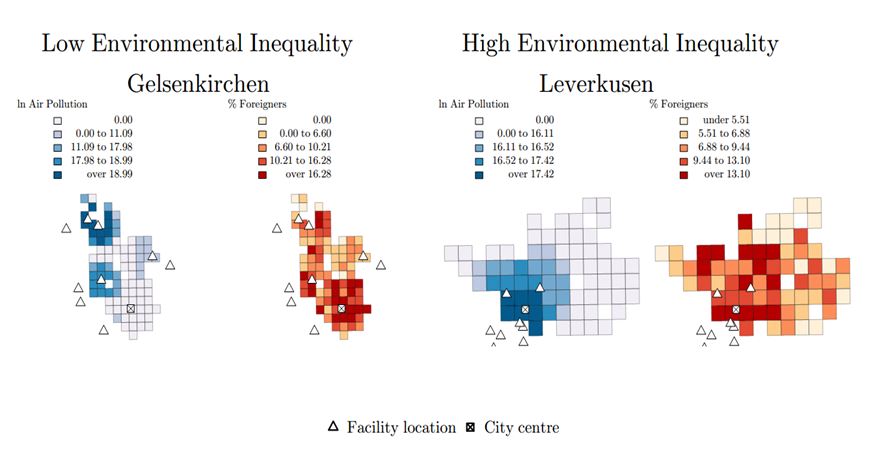Bringing urban space back in: A multilevel analysis of environmental inequality in Germany
Blog by Tobias Rüttenauer
- Created
- 13 Nov 2018, 4:02 p.m.
- Author
- Tobias Rüttenauer
- DOI
- 10.1177/0042098018795786
Abstract: https://journals.sagepub.com/doi/full/10.1177/0042098018795786#abstract
Motivation and background
Research demonstrates that in many countries, areas with large minority shares tend to have more environmental pollution. Also in Germany, we find a relatively large correlation between the percentage of foreigners and the amount of air pollution, documenting a severe dimension of social inequality given the impact of exposure to environmental pollution on health and other social outcomes. However, as can be seen below, the magnitude of the correlation between minority share and pollution (i.e. the disadvantage of minorities) varies considerably between the cities. Thus, the aim of this study is to investigate why some cities exhibit high levels of environmental inequality while others do not.
Source: German census 2011 and E-PRTR pollution database.
Environmental inequality can arise from two different mechanisms: selective siting and selective migration. Selective siting assumes that polluting facilities, such as industrial factories or waste treatment plants, are sited closer to minority residents because of lower political protest. Selective migration hypothesises that minorities are more likely to move into polluted areas because of lower housing costs or discriminatory barriers. These mechanisms suggest that residential segregation, economic inequality and political efficacy should be correlated with higher levels of environmental inequality.
However, previous results point towards two alternative explanations. First, minorities might live close to hazardous facilities because of favourable job opportunities in the industrial sector. Second, environmental inequality might depend on the spatial distribution of environmental hazards within the urban space. For instance, previous research has shown that immigrant-minorities tend to cluster around the urban core because of social networks and infrastructural opportunities. If, at the same time, high pollution occurs around the urban core, we would observe a higher environmental burden of minorities.
The figure below depicts this argument graphically. In Gelsenkirchen and Leverkusen, minorities agglomerate around the city centre. However, industrial facilities are located quite close to the city centre in Leverkusen and rather peripheral in Gelsenkirchen, which leads to a high level of environmental inequality in Leverkusen and a low level in Gelsenkirchen.
Source: German census 2011 and E-PRTR pollution database.
Data and Method
The study combines 2011 German census data with air pollution estimates of the European Pollutant Release and Transfer Register (E-PRTR), containing emission data of highly polluting industrial facilities. I use multilevel models with city-fixed effects in order to show how the correlation between the share of foreigners and industrial air pollution varies by city-level characteristics (cross-level interaction).
Results and Discussion
The results reveal that the city-level predictors derived from the standard strand of theoretical reasoning do a rather poor job of explaining the varying level of environmental inequality. The geographic centrality of industrial facilities, in contrast, exhibits a highly robust and strong correlation with the level of environmental inequality: The closer the polluting facilities to the city centre, the higher the environmental burden of minorities.
Does this finding mean that minority share and environmental pollution are not causally linked but driven by the proximity to the city centre? Interestingly, the centrality of industrial facilities is not statistically related to the geographic centrality of the foreign population. Consequently, environmental inequality could be the unintended consequence of two independent processes: minorities agglomerate around the urban core across all cities because of better network and other infrastructural opportunities, and many cities exhibit a high level of pollution in central areas. The crucial question is then, why do some cities manage to displace industrial facilities to peripheral areas while others do not? Having a closer look at the spatial distribution of environmental hazards within the urban space might help to reduce the persisting disadvantage and environmental burden of minority groups.

Read the paper on Urban Studies - OnlineFirst here




Comments
You need to be logged in to make a comment. Please Login or Register
There are no comments on this resource.